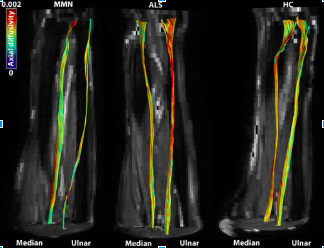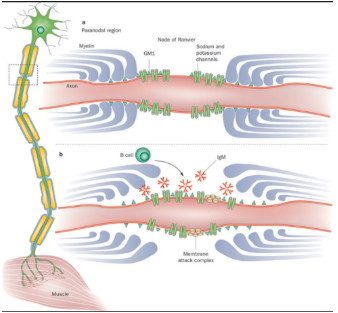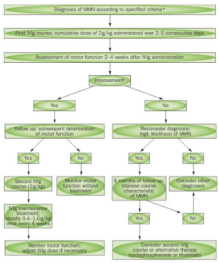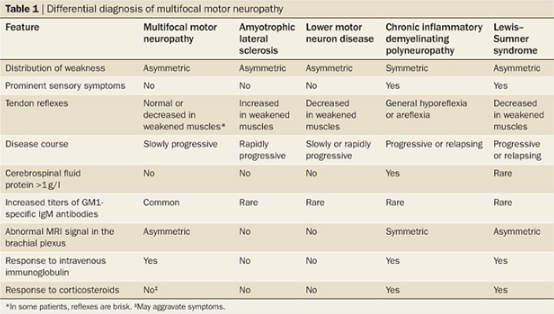Multifocal Motor Neuropathy
Be the first to edit this page and have your name permanently included as the original editor, see the editing pages tutorial for help.
Clinically Relevant Anatomy
[edit | edit source]
Multifocal motor neuropathy (MMN) is a rare disorder predominantly causing weakness in the distal limbs (1). The disorder is purely a motor neuropathy that presents asymmetrically and progresses slowly(1). To distinguish MMN from a motor neuron disease, a conduction block was found as the electrophysiological characteristic (2-4). Axon death occurs due to the lack of conduction which can lead to an entire nerve being affected. The nerves that are typically affected are peripheral nerves and more commonly the radial, ulnar, median and tibial nerves, however; it can affect other nerves as well (1,13). Since its symptoms are similar to that of chronic inflammatory demyelinating polyradiculoneuropathy (CIDP) in that they both occur due to a conduction block, it has been said that MMN is likely an immune-mediated neuropathy (source on doc).
Figure 1: Comparison of the fibre tractography of the ulnar and median nerves in individuals with MMN (left), ALS (middle) and healthy controls (right). The colours indicated correspond to the axial diffusivity (mm2/s) which is correlated with axonal degeneration (source in doc).
Figure 2: Demonstration of the conduction of electrical signal being blocked on the axon of individuals with MMN (source).
Epidemiology/Prognosis
[edit | edit source]
MMN more commonly affects males in comparison to females with a ratio of 2.7:1(1). Symptoms do not typically appear before the age of 50 years old(1). Men typically experience an earlier onset of MMN symptoms compared to females (1). MMN is not typically found in individuals over 70 years old (1).
The disorder is very similar to amyotrophic lateral sclerosis, however; MMN is seen as a treatable disorder with a good prognosis (10). MMN does not often negatively affect an individual’s lifespan, however; quality of life is often compromised due to symptoms like poor dexterity in manual tasks that are needed for activities of daily living. (Guimarães-Costa R, Bombelli F, Léger J. Multifocal motor neuropathy. Current opinion in neurology. 2013;26:503.) When compared to other diseases such as lower-motor-neuron disease, patients with MMN have a better overall prognosis (source on doc)
Mechanism of Injury / Pathological Process
[edit | edit source]
Clinical Presentation[edit | edit source]
Symptoms:
- Asymmetrical distal limb weakness, which follows a nerve path, but does not include sensory loss (typically tibial, radial, ulnar and median nerves) (1,13).
- Wrist drop is usually the first symptom seen along with foot drop and a reduction in grip strength (1,13).
- Symptoms typically start in the leg and typically move to the arm. Later on symptoms may move to the upper arm but rarely move to the upper leg (1).
- Weakness tends to increase when exposed to cold environments (14).
- Patients who have the disease for a long time will typically experience muscle atrophy (12,13).
- Cramps and fasciculations appear in over 50% of patients (12).
- Decrease in tendon reflexes in the affected muscles are common (12).
- In rare cases, respiratory issues may occur because of the involvement of the phrenic nerve (16-19).
- Over 50% of patients experience significant fatigue that affects their daily living and careers (1).
Diagnostic Procedures[edit | edit source]
Diagnosis of MMN is found using clinical and electrophysiological characteristics (5). The results can be supported using ancillary investigations which may present as normal or slightly elevated CSF protein, abnormal signals in the brachial plexus as seen in an MRI, and blood work to assess GM1-specific IgM antibodies (15, 20, 22-24). Ultrasonography has also shown enlargements along the brachial plexus in about 90% of patients (12).
Figure 3: Flowchart of method of diagnosing MMN (55)
Outcome Measures[edit | edit source]
- Grip Strength
- Rasch-built overall-disability scale (MMN-RODS)
- INCAT Disability Scale
- Fatigue Scale for Motor and Cognitive Functions
- Motor Assessment Scale
- Wolf Motor Function Test (upper extremity strength and function)
add links to outcome measures here (see Outcome Measures Database)
Medical Management / Interventions
[edit | edit source]
add text here relating to management approaches to the condition
Differential Diagnosis
[edit | edit source]
add text here relating to the differential diagnosis of this condition
Figure 4: Methods of differentiating between MMN and other possible diagnoses (source)
Key Evidence[edit | edit source]
add text here relating to key evidence with regards to any of the above headings
Resources
[edit | edit source]
add appropriate resources here
Case Studies[edit | edit source]
add links to case studies here (case studies should be added on new pages using the case study template)
References[edit | edit source]
References will automatically be added here, see adding references tutorial.










